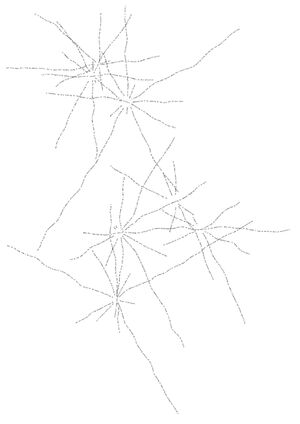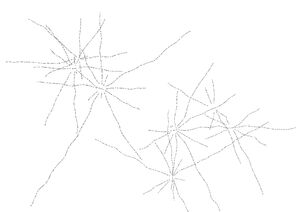|
|
| (52 intermediate revisions by 2 users not shown) |
| Line 1: |
Line 1: |
| <div class="article Myclines layout-1"> | | <div class="article Myclines layout-1" id="Mycelines:_A_Sympoetic_Imagination"> |
|
| |
|
| | <div class="hide-from-book scriptothek"> |
| | [[File:Visualzation Sally.jpg|thumb|In this version of Myclines, the text corpus is based on the content from [[#Re-_and_Un-_Defining_Tools]]. See also the animated version: https://chenqianxun.com/mycelines/]] |
| | </div> |
|
| |
|
| === Mycelines: A Sympoetic Imagination === | | === Mycelines: A Sympoetic Imagination=== |
| | <span class="author">Qianxun Chen</span> |
| | <div class="block"> |
| | A Myceline (a neologism made up of ‘mycelium’ and ‘line') is a “line” of text that grows like a mycelium. Mycelines can be generated based on a word-in-context analysis of one piece or multiple pieces of text. A shared word between two sentences has the potential to become a “node,” enabling new mycelines to grow from it. It breaks the linear, one-directional flow of the written language and demonstrates how interconnected our language is with new visual representations and evolving textual behaviors. |
| | In ''Staying with the Trouble''<ref> Donna Haraway, "Staying with the trouble : making kin in the Chthulucene" (Durham: Duke University Press, 2016)</ref>, Donna J. Haraway introduced the term ''sympoiesis'' based on ''autopoiesis'', Sympoiesis means “making-with”, or “[[#Platframe_Postscript|collectively-producing systems]] that do not have self-defined spatial or temporal boundaries. Information and control are distributed among components. The systems are evolutionary and have the potential for surprising change.” By contrast, autopoietic systems are “self-producing” autonomous units “with self defined spatial or temporal boundaries that tend to be centrally controlled, homeostatic, and predictable.” |
|
| |
|
| <span class="author">By Qianxun Chen</span> | | If we apply this way of thinking to words and text, to think about autopoietic as auto-poetics, auto-poetic can then be used to describe generative textual systems with centrally defined generative rules, while sym-poetic are for texts that are collectively produced among various dynamic components. Mycelines are created with sympoetic in mind. Here, words decide how they organize themselves spatially based on the flow of each sentence instead of following one predefined direction, allowing concepts and thoughts interact and merge in a process akin to anastomosis in fungal networks. |
| | The Code below shows the process of word in context analysis of the text [[#Re-_and_Un-_Defining_Tools|“Re-, Un-, Defining Tools”]] by the Feminist Search Tools working group. We can see that words such as “tool”, “think”, “conversation” and “process” are mentioned the most, which make them important nodes in the generated myceline network.<br> |
|
| |
|
| A Myceline is a new form of digital textual existence inspired by the way how a mycelial network grows and interacts. It can be generated based on a word-in- context analysis of one piece or multi pieces of text. A shared word between two sentences has the potentiality to become a Node, so that new mycelines can grow out of it. It breaks the linear, one directional flow of the written language and demonstrates how interconnected our language is with a new visual representation and textual behaviours.
| | ::<small>'''Qianxun Chen''' is a media artist, programmer and researcher. She works at the intersection of art, technology and language, with a focus on generative poetics, the aesthetics of algorithm and digital textuality. Her works tend to bring up artistic and non-human perspectives of the world through alternative usage of technology.</small> |
| | <span class="page-break"> </span> |
|
| |
|
| | <code> |
| | Concorder = class |
| | conversationText = FileAttachment { |
| | :name: "conversation.txt" |
| | :mimeType: "text/plain" |
| | :<prototype>: FileAttachment {} |
| | } |
|
| |
|
| In Staying with the Trouble, Harraway suggested sympoiesis instead of autopoiesis for the Chthulucene, a “collective-producing systems that do not have self-defined spatial or temporal boundaries. Information and control are distributed among components. The systems are evolutionary and have the potential for surprising change.” If we focus ourselves to words and texts, this turn can be interpreted as auto-poetics to sym-poetics: to let the words weave and decide how they organise themselves spatially instead of following concrete pre-defined directions, to let the concepts and thoughts interact and merge into each other as the anastomosis in fungal networks.
| | ct = await conversationText.text() |
| In this version, the text corpus is based on the content from Re-, Un-, Defining Tools.
| |
| | |
| | |
| <span class="spread">[[File:Visualzation Sally.jpg|thumb]]</span>
| |
| | |
| | |
| Concorder = class
| |
| newConcorderTester = Array(14) [
| |
| 0: "Myriad tentacles will be needed to tell the story …ing roots, reaching and climbing tendrilled ones."
| |
| 1: "But like Latour and even more like Le Guin, one of…rs, Stengers is adamant about changing the story."
| |
| 2: "That a symbiotic system — coral, with its watery w…bal transformation will come back into our story."
| |
| 3: "And at the same time, every imaginable, and many u…e first and the last beautiful words and weapons."
| |
| 4: "The story of Species Man as the agent of the Anthr…, only to end in tragic detumescence, once again."
| |
| 5: "Coal and the steam engine did not determine the st…lizing” transformations shaping the Capitalocene."
| |
| 6: "As a provocation, let me summarize my objections t… Anthropos is a setup, and the stories end badly."
| |
| 7: "It is hard to tell a good story with such a bad actor."
| |
| 8: "Bad actors need a story, but not the whole story."
| |
| 9: "That is the story of History human exceptionalists tell."
| |
| 10: "We need another figure, a thousand names of someth… the Anthropocene into another, big-enough story."
| |
| 11: "All of these stories are a lure to proposing the C…rucial for ongoing, for staying with the trouble."
| |
| 12: "The order is reknitted: human beings are with and … abiotic powers of this Earth are the main story."
| |
| 13: "Diverse human and nonhuman players are necessary i…tissues of the urgently needed Chthulucene story."
| |
| ]
| |
| | |
| carrierText = FileAttachment {
| |
| name: "carrier@1.txt"
| |
| mimeType: "text/plain"
| |
| <prototype>: FileAttachment {}
| |
| }
| |
|
| |
|
| tentacularText = FileAttachment {
| | concordance = new Concorder(text, { |
| name: "tentacular@1.txt"
| |
| mimeType: "text/plain"
| |
| <prototype>: FileAttachment {}
| |
| }
| |
|
| |
|
| rm = n {
| | :ignoreCase: true, |
| n: 3
| | :ignoreStopWords: true, |
| root: n {children: Object, parent: null, token: "ROOT", count: 0, numChildren: -1}
| | :ignorePunctuation: true, |
| trace: undefined
| | :isSentenceLevel : true |
| mlm: undefined
| |
| logDuplicates: undefined
| |
| maxAttempts: 999
| |
| disableInputChecks: undefined
| |
| tokenize: ƒ()
| |
| untokenize: ƒ()
| |
| input: Array(0) []
| |
| <prototype>: n {}
| |
| }
| |
|
| |
|
| | }); |
|
| |
|
| | cAnalysis = getAnalysis(concordance) |
|
| |
|
| | cAnalysis = Object {<br> |
|
| |
|
| | | ::tool: Array(67) |
| !/bin/bash
# init: remove existing data and initialize new game-session
| | ::think: Array(18) |
| create file to keep track of chosen members
if [ ! -e ./.members ]; then
touch ./.members
else
rm ./.members && touch ./.members
fi
# create moderation folder where to move emails
# from `<mlmmj>/<list>/moderation`
if [ ! -d ./moderation ]; then
mkdir ./moderation
else
rm -rf ./moderation && mkdir ./moderation
fi
# delete .game-over mark
rm -rf ./.game-over
| | ::tools: Array(15) |
| ct = await carrierText.text()
| | ::conversation: Array(18) |
| | | ::something: Array(16) |
| getAnalysis = ƒ(…)
| | ::process: Array(16) |
|
| | ::library: Array(10) |
| sharedContext = ƒ(a, b, c)
| | ::digital: Array(14) |
|
| | ::project: Array(13) |
| test = Array(3) [
| | ::way: Array(12) |
| 0: "That is the story of History human exceptionalists tell."
| | ::different: Array(9) |
| 1: "The order is reknitted: human beings are with and … abiotic powers of this Earth are the main story."
| | ::make: Array(11) |
| 2: "Diverse human and nonhuman players are necessary i…tissues of the urgently needed Chthulucene story."
| | ::gender: Array(8) |
| ]
| | ::part: Array(10) |
| | | ::through: Array(8) |
| ctAnalysis = Object {
| | ::search: Array(9) |
| ctAnalysis = Object {
| | ::find: Array(7) |
| story: Array(22)
| | ::catalog: Array(8) |
| human: Array(9)
| | ::question: Array(8) |
| things: Array(8)
| | ::… more<br> |
| hero: Array(10)
| |
| bag: Array(9)
| |
| oats: Array(8)
| |
| telling: Array(7)
| |
| container: Array(6)
| |
| … more | |
| } | | } |
|
| |
|
| tAnalysis = Object {
| | <br> |
| anthropocene: Array(30)
| | </code> |
| human: Array(25)
| | </div class="block"> |
| stories: Array(17)
| |
| capitalocene: Array(17)
| |
| gaia: Array(13)
| |
| chthulucene: Array(15)
| |
| story: Array(14)
| |
| man: Array(12)
| |
| called: Array(13)
| |
| earth: Array(9)
| |
| anthropos: Array(12)
| |
| beings: Array(10)
| |
| critters: Array(12)
| |
| term: Array(10)
| |
| history: Array(11)}
| |
|
| |
|
| sortDict = ƒ(dict)
| | [[File:Vertical p2.jpg|thumb|In this version of Myclines, the text corpus is based on the content from [[#Re-_and_Un-_Defining_Tools]]See also the animated version: https://chenqianxun.com/mycelines/]] |
| | |
| | |
| | |
| [[File:Vertical p2.jpg|thumb]] | |
| | |
| ''In this version, the text corpus is based on the content from Re-, Un-, Defining Tools.
| |
| ''
| |
|
| |
|
| | <span class="spread">[[File:Visualzation Sally.jpg|thumb]]</span> |
|
| |
|
| </div> | | </div> |

